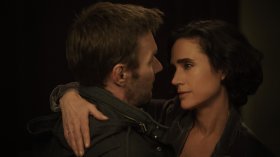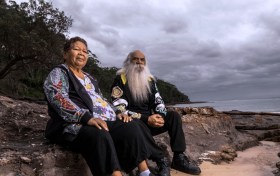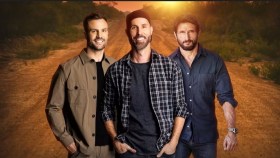Image: Australia to industry – just spend the money on dogs.
Screen Australia has tracked 33 features, which fits the remarkably consistent average for the last five years. But the domestic expenditure without official co-productions is $120m, well down from the average of $197m.
The TV sector made 43 drama titles, slightly down on the average of 45. But the spend is $279m, the worst in five years, which averages $317m.
In general, the total expenditure on producing drama in Australia for the year was $837m, of which $420m was spent on Australian projects, and $418m by foreign productions. That total is down $120m on the five year average.
What do we make of those numbers? As always, we have to introduce two giant caveats. The figures bounce around horribly because the international productions come and go. And Screen Australia adheres to the standard reporting convention that counts the total expenditure as occurring on the day when the final contracts were signed. The actual expenditure may start much later, and occur over several years.
According to Graeme Mason, CEO of Screen Australia, the drop in feature expenditure is caused by the absence of overseas investment in Australian films. The cost of production is borne domestically.
That is partly to do with the rise of lower budget films which attract less overseas interest, the general slippage in distribution guarantees for non-tentpole films and the absence of any high budget Australian films financed by an an American studio.
The television number is more of an issue for Screen Australia. ‘Drama is coming off a very high level’, he said, ‘but some broadcasters are really struggling.’
It is no secret that networks are responding to the splintering of audience and declining advertiser revenues by pushing budgets down, while 51% of Nine’s drama hours actually contain shows made in New Zealand.
What is more, he said, ‘This is all happening before the cuts to the ABC and SBS which may be passed on.’
To add to the general sense of industry instability, the new normal is short run series, typically much shorter than even the thirteen eps which looked like it might be the benchmark for a while. That change brings benefits, in that it creates greater diversity on all levels for an industry which survived for a generation on the long-running serials.
Screen Producers Australia has used the same figures to inject a moderate but measured sense of crisis. ‘Australian TV at critical juncture – Screen Producers Australia calls for urgent measures.’ Is the headline to its announcement.
‘Mr Deaner [SPA CEO] pointed to continued falls in the number of adult drama hours produced, with 2014-15 levels at their lowest point in a decade. Contributing to this trend are several factors, including a move to shorter series as well as sharp declines in commercial television commissioning.’
Indeed, the five year figures put meat on those bones.
10/11 – 489 hours, costing $76m
11/12 – 470 – 264
12/13 – 502 – 305
13/14 – 472 – 291
14/15 – 401 – 235
While Deaner sounds a warning over the impact of those ABC and SBS cuts, he also takes the opportunity to push for a change in the attitude to foreign actors – although the Media Entertainment and Arts Alliance will be happy with the status quo in dealing with two major overseas productions in the one year.
The numbers for foreign productions in Australia are all over the place. There were fourteen titles, with a total of $397m spent here. The year before, also a record, was $203m. The five year average is $175m.
In 2016 we have Thor and Pandemonium 2, with a suggestion that no less than three Chinese films will come as well. Depending on when they start, that figure could climb even more or create a flat 2015-16 followed by a gigantic year after that.
Generally, the five year average between domestic and overseas production is pretty comparable, though it climbed so fiercely over 2014-15 it was 1:3, caused mostly by Pirates of the Caribbean.
Is that distorting the marketplace for Australian crew? Local shows may be threaded through international downtime, but Mason maintains that generally there is no statistical indication of a two-tier industry.
Where is the investment money coming from? For features, we see
Offset – $39m – 30%
Agency investment – $25m – 20%
Industry sources – $25m – 19%
Foreign – 19% – $25m
Private – 11% – $15m
For television, we see
Industry – 60% – $201m (with 93m from commercial FTA networks)
Offset – 11% – $37m,
Agency investment – 10% – $33m
Private – negligible.
Those figures add fuel to SPA’s campaign to increase the TV Offset from 20% to 40%, which is part of its latest announcement. At the moment it is $33m, so doubling it would create a total of $66m. In crude terms, that would take the expenditure back to the long term average, so we are not talking about a huge increase in production.
Screen Australia’s own contribution to television rose last year from $18m on 19 titles to $21m on $22m titles. The agency supported 47% of titles, compared to an average of 40%.
Given that its commitment is relatively minor compared to presales and investments, should Screen Australia drop out of television drama? ‘I would suggest we have a pivotal role,’ said Mason. ‘Mostly the broadcasters want us to be involved in the first series. We help them establish shows, and normally we then pull out altogether or take a much lower percentage.. We will remain in TV series because without us, they are not going to happen.’
The spread of budgets on features is changing significantly. In the $1m-$3m range Australians doubled the number of any other year, up to 18. The $3-6m films are now under the five year average.
So, 67% of budgets are now under $3m, 22% are now in the $3-6m space, 3% are in $6-10m and $12% are over $10m.
So the great majority of features now cost less than $3m, and we are evacuating that middle range even though the actual amount of money spent in that space is still probably higher than any other.
In previous years, Mason has argued in favour of this shift, which is all part of the general move to create budgets in sync with possible returns. Now he acknowledges that Australian films rarely make their money back. And ‘The true realistic prospects of Australian films is that recoupment can only happen if you play internationally. That is a rare thing here.’
He argues that budgets for films without cast need to stay very low. ‘If I wanted to go broader’, he said, ‘I would not go for $5m but $8 to $10m and add stars’.
‘Normally people here just expand the crew and the numbers of days shooting without thinking it through. They turn a $3m film into a $7m film without adding any more elements. That is the fundamental problem I perceive in Australia.’
“No-one else is doing it, and we scare off international investors because they are going to think we are expensive.’
Mason’s political position is different from SPA. Going into an election year, he wants to be able to argue that the sector is doing well, and extra support will allow it to do better.
That does not quite correspond to the nasty feeling around the industry that cuts are becoming increasingly destructive. The closure of the Screen Resource Organisations is merely the first example of losses to a finely balanced system.
These numbers themselves don’t make any case. Mason points to the audience figures in both the cinemas and on TV to maintain that we have been having a stellar year.
Historians would say that the glory years have gone, but that is not the point. In a splintered, foreign dominated market, solid Australian films aimed at broad audiences have been doing well. The smaller films are appearing at key festivals and are made with considerable assurance. In television, audiences are turning on for local drama and networks use it to define their brand.
In some ways, two kinds of mystery ultimately cohere around the same problem. The box office is pushing the price of Australian features down, and cinema attendances suggest a tale of financial woe. No-one is making returns out of the domestic box office, as Mason concedes.
But we don’t know about the real state of the long tail. Is it really true that it has fallen to pieces with the death of DVDs? Or have we created a long term stable market for micro-cultures of fans?





